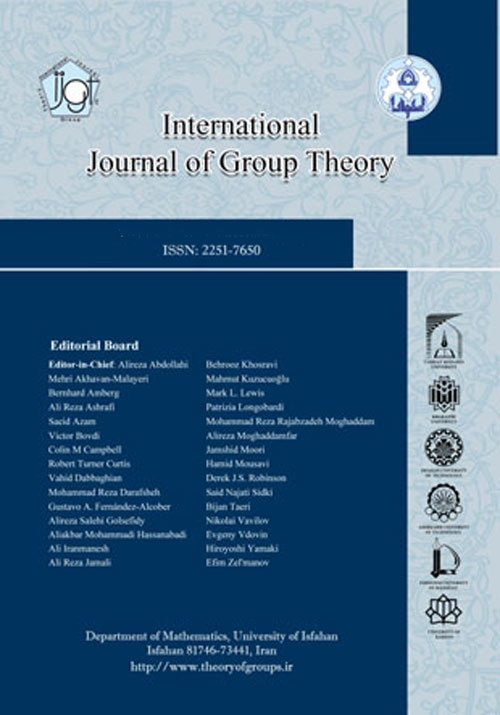فهرست مطالب

International Journal of Group Theory
Volume:4 Issue: 1, Mar 2015
- تاریخ انتشار: 1393/11/25
- تعداد عناوین: 6
-
-
Pages 1-6In a previous paper, the second author established that, given finite fields $F < E$ and certain subgroups $C leq E^times$, there is a Galois connection between the intermediate field lattice ${L mid F leq L leq E}$ and $C$''s subgroup lattice. Based on the Galois connection, the paper then calculated the irreducible, complex character degrees of the semi-direct product $C rtimes {Gal} (E/F)$. However, the analysis when $|F|$ is a Mersenne prime is more complicated, so certain cases were omitted from that paper.The present exposition, which is a reworking of the previous article, provides a uniform analysis over all the families, including the previously undetermined ones. In the group $Crtimes{rm Gal(E/F)}$, we use the Galois connection to calculate stabilizers of linear characters, and these stabilizers determine the full character degree set. This is shown for each subgroup $Cleq E^times$ which satisfies the condition that every prime dividing $|E^times: C|$ divides $|F^times|$.Keywords: Galois correspondence, lattice, character degree, finite field
-
Pages 7-12We characterize strictly diagonal type of embeddings of finitary symmetric groups in terms of cardinality and the characteristic. Namely, we prove the following. Let $kappa$ be an infinite cardinal. If $G=underset{i=1}{stackrel{infty}bigcup} G_i,$ where $ G_i=FSym(kappa n_i)$, $(H=underset{i=1}{stackrel{infty}bigcup}H_i, $ where $ H_i= Alt(kappa n_i)), $ is a group of strictly diagonal type and $xi=(p_1, p_2, ldots)$ is an infinite sequence of primes, then $G$ is isomorphic to the homogenous finitary symmetric group $FSym(kappa)(xi)$ ($H$ is isomorphic to the homogenous alternating group $Alt(kappa)(xi))$, where $n_0=1, n_i=p_1p_2 ldots p_i$.Keywords: Finitary symmetric groups, Centralizer, Locally finite simple groups
-
Pages 13-19The Freiheitssatz of Magnus for one-relator groups is one of the cornerstones of combinatorial group theory. In this short note which is mostly expository we discuss the relationship between the Freiheitssatz and corre- sponding results in free power series rings over fields. These are related to results of Schneerson not readily available in English. This relationship uses a faithful representation of free groups due to Magnus. Using this method in free polynomial algebras provides a proof of the Freiheitssatz for one-relation monoids. We show how the classical Freiheitssatz depends on a condition on certain ideals in power series rings in noncommuting variables over fields. A proof of this result over fields would provide a completely dif erent proof of the classical Freiheitssatz.Keywords: Freiheitssatz, one, relator group, Magnus representation, formal power series rings
-
Pages 21-32This paper gives a short survey of some of the known results generalizing the theorem, credited to I. Schur, that if the central factor group is finite then the derived subgroup is also finite.Keywords: Schur theorem, Baer theorem, finite rank
-
Pages 33-39Quasinormal subgroups have been studied for nearly 80 years. In finite groups, questions concerning them invariably reduce to p-groups, and here they have the added interest of being invariant under projectivities, unlike normal subgroups. However, it has been shown recently that certain groups, constructed by Berger and Gross in 1982, of an important universal nature with regard to the existence of core-free quasinormal subgroups gener- ally, have remarkably few such subgroups. Therefore in order to overcome this misfortune, a generalization of the concept of quasi- normality will be defined. It could be the beginning of a lengthy undertaking. But some of the initial findings are encouraging, in particular the fact that this larger class of subgroups also remains invariant under projectivities of finite p-groups, thus connecting group and subgroup lattice structures.Keywords: p, groups, quasinormal, products
-
Pages 41-46Groups of infinite rank in which every subgroup is either normal or self-normalizing are characterized in terms of their subgroups of infinite rank.Keywords: infinite rank, normalizer subgroup, locally graded group

